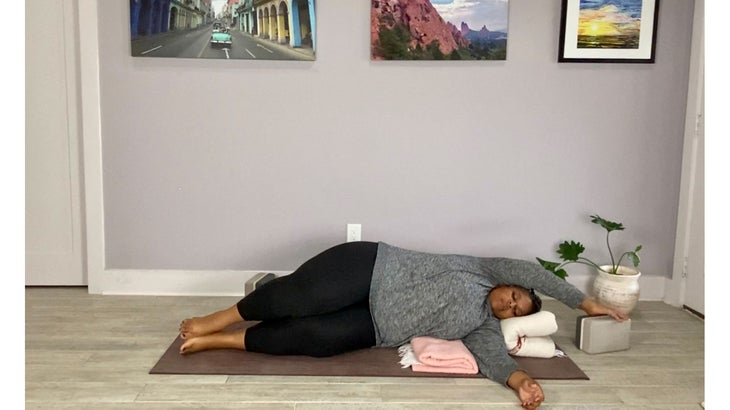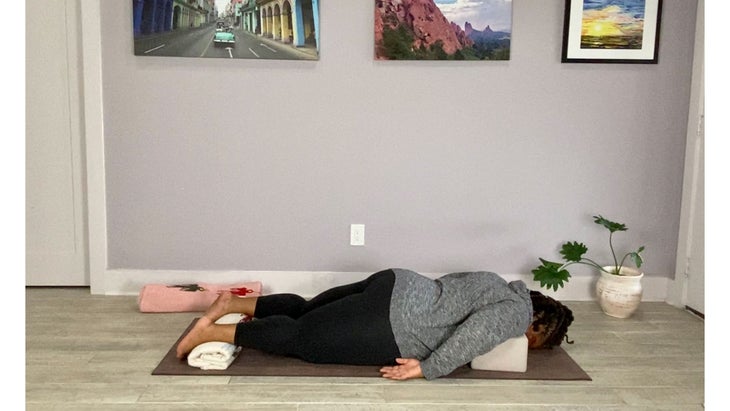Heading out the door? Read this article on the new Outside+ app available now on iOS devices for members! Download the app.
I don’t know about you, but I’ve been getting more irritable lately. Do I have tools to cope with pandemic living? Yes. Do I have the awareness to know when I’m shame-spiraling into an abyss of anxiety, sadness, and anger? Yes. Does that mean that I immediately go to my happy place when I need it? No.
The reality is that life is full of challenging moments. Even though you might have the tools to get through difficult times, sometimes they get dull and need to be sharpened.
I used to think that a powerful, sweaty class was enough to give me a reset. More recently, I understand that I was escaping my mood—not shifting it. I’d channel all my ire into my practice, get drippy with exertion, and head to the shower, which would feel like a baptism from which I was reborn! I’d then get in my car and hit traffic or try go to sleep and still be distracted by everything that had been frustrating me before my practice. Why? Even though I had taken some space away from the situation, I wasn’t processing it or approaching it differently.
Eventually, I found a real way to reset—through restorative yoga.
In yoga, we often talk about the distinction between yang energy (which is more about doing and forcing things) and yin energy (which comes more from a place of surrender). I always say, “There is no amount of yang to offset yang. Only yin can do that.” Here we are talking about yin with a lowercase y. Not as in the style of Yin Yoga, although that can be conducive to taking us to a place of quiet acceptance.
Whether we realize it or not, we are all yearning for quieter asana practices to offset the cacophony of our busy and sometimes chaotic lives. By cultivating the opposite energy, we’re able to legitimately shift our perspectives, our moods, and our lives. A bad mood sometimes happens because someone cut you off in traffic or jumped in front of you in line at the airport. But it can also be because you got devastating news about a loved one or have empathetically experienced traumatizing world events. (And if the latter is the case, may I recommend my Yin Yoga practice for when you feel outrage?)
We can’t always sweat something out or let it go. But we can create a space where we can let it be for a while. Restorative yoga gives us an opportunity to create so much comfort and rest that it becomes possible to allow ease and calm to arise, whether alongside the feelings about difficulties in life or perhaps by replacing them entirely.
See also: These Yoga Poses Will Help You Relax (Even If You’re Really, Really Stressed)
4 restorative yoga poses to help you reset
Restorative yoga is such an important self-regulation practice. Whenever you need a complete mood reset, allow these postures to help you approach the rest of your day entirely differently.
What you will need: 3 blankets (or bath towels); 1 bolster (or a pillow). You might also need blocks and a strap (or a belt).

Mountainbrook
We’ll build this pose from the head down. You’ll need 3 blankets. Fold a blanket in half and then fold it in half again in the other direction to make a rectangle. Place it at the back of the mat and roll the long edge closest to you over to create a gentle support for your neck. Take another blanket and fold it in half twice to create another rectangle and place this in the middle of the mat to support your rib cage. Sit facing away from your blankets and bring a bolster (or a couple pillows) under your knees. You might need to bring blocks beneath your thighs to feel fully supported by the bolster. Then roll the last blanket for support under your ankles. Lie down adjusting the blankets and bolster to fill all the negative spaces (unsupported spaces) along your back body. Bring the end of the blanket that was under your head and neck to hood your eyes and ears. Stay for at least 10 minutes, then roll to your side of choice, and take time coming to seated.

Side-Lying Stretch
Keep the blanket that was under your shoulders in place to support your side body. Create a pillow for your head by folding the blanket underneath your neck into a small square or you can use a sturdy pillow. You want your neck to be in line with the rest of your spine. Roll onto your side of choice and reach your bottom arm (the one that’s in between the pillow and side body-supporting blanket) straight out from your shoulder. You can rest your top arm along your body or, for more of a shoulder stretch, reach it alongside your ear and rest your hand on the mat or the block. (Turn the block to whatever height feels relaxing for your shoulders.) Rest here for 10 minutes. If you like, you can bring a blanket between your shins. Move through all-fours to switch sides.

Supported Locust
Roll a blanket and place it at the back of the mat to support your ankles. Come to lying face-down with the tops of your feet on the blanket roll. Bring a block on medium height underneath your upper arm bones to support your shoulder area. Internally rotate your arms so that your palms face the ceiling. If it’s comfortable for you, bring the space between your eyebrows to the mat. If not, place a blanket under your forehead. If you have any low back sensitivity, roll another blanket and slide it beneath your hips for support. Rest in this prone posture for at least 10 minutes. To come out, press yourself through hands and knees and back into Child’s Pose.

Legs up the Wall
Place a blanket on the floor to cushion your entire back body. Sit with one of your hips alongside the wall and swing your legs up the wall. If you have a difficult time relaxing your legs, you can use a strap (or belt) between your knees and shins to keep your legs in place. You can place the rolled edge of a blanket under your neck, as you did earlier in your practice, and bring the rest of the blanket over your eyes. Allow your arms to relax wherever is comfortable for you. Remember the point is to relax, so let the wall and the ground support you. Rest in this pose for a minimum of 15 minutes. To come out, slowly bring the soles of your feet to the wall, then roll to one side, and make your way seated.
See also: More Restorative Yoga Poses
About our contributor
Tamika Caston-Miller is an E-RYT 500 with a special interest in yoga for renewal, transformation, and social justice. Her yoga journey began in 2001 with a home practice. She now holds certifications from YogaOne Studios, Yogaworks, Kripalu School of Yoga, Judith Hansen Lasater, and Paul Grilley. Tamika’s teaching and practice have been informed by chronic pain and injuries, the very human battle between shame and compassion, the quest for ancestral healing, and love for the practice and philosophy of yoga.
More from Tamika Caston-Miller: Traveling? Take This Prop-Free Yin Practice With You